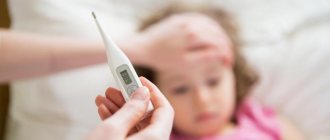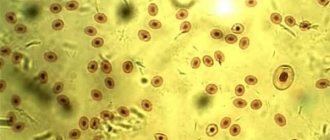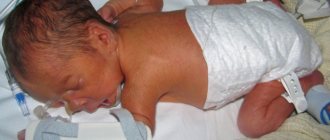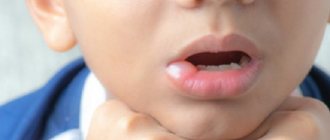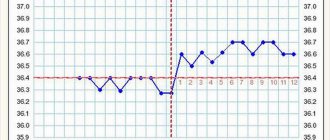Temperature norm
The normal body temperature of a baby is in the range from 36 to 37.4 degrees. During the first 10 months she jumps for many reasons. The norm for an adult is considered to be 36.6 degrees. Around 10-12 months it becomes like this in small children.
If a slight increase in the mark on the thermometer is detected in a 10-month-old child, but at the same time he is calm and eats well, perhaps this is the norm at this point in his development. To determine how many degrees is normal for a child, you can monitor the temperature for several days. Measurements must be taken at the same time.
Many factors influence how many degrees the thermometer will show.
- The place where the measurement is made. The temperature in the mouth or rectum will be slightly higher than in the armpit area.
- Type of thermometer. The most accurate is a mercury thermometer. An electronic thermometer can distort data up to several degrees.
- After eating, bathing, or prolonged crying, the mark on the thermometer can rise up to 38 degrees. After sleep, or when the child is cold, a low temperature is observed.
A change in the indicator on the thermometer is a consequence of stress, overheating, a virus, or teething. It may also increase after vaccination. Do not lower the temperature of a child over 3 months below 38.2 degrees. But this is only if there are no contraindications.
Doctors advise giving antipyretic and antihistamines immediately after vaccination. Vaccinations such as BCG and hepatitis B are not accompanied by fever. Vaccinations against polio rarely give a reaction above 38 degrees.
How is high temperature treated in infants?
To lower a baby's body temperature by 1-2 degrees, it is not necessary to use antipyretics. For this it is enough:
- create a comfortable temperature in the room: either maintaining the temperature at 20 degrees, or periodically ventilate the room in the absence of the child);
- dress the baby in clothes that are not too warm - so that he does not freeze, but does not feel hot;
- prepare and constantly offer fresh and lukewarm drinks;
- do not involve the child in active games, provide him with a quiet pastime;
Various temperature levels in children
In the case when the child’s body temperature is above 36.6 degrees, parents begin to worry, but this is not always justified.
In the first days after birth, body temperature is about 38 degrees. By the end of the first month it reaches 37 degrees. But the temperature is not always the same number. Adults see that she is constantly jumping.
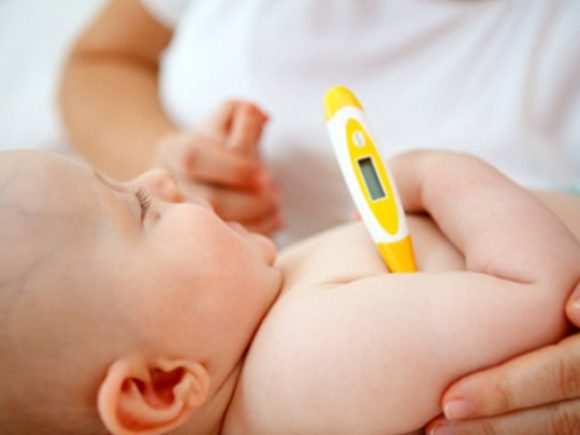
Over 1 month, body temperature can rise to 38 degrees after vaccination, when the first teeth erupt, due to a lack of fluid, especially in hot weather.
If the number on the thermometer is above 38.2 degrees, this in most cases indicates that pathogenic microbes have entered the body. But even in this case, a decrease in temperature is not required. Suppositories, syrups and other antipyretics can disrupt the process of natural thermoregulation. A high mark on the thermometer is an indicator of the body's fight against infection.
If the increase occurs up to 38.5 degrees, an antipyretic should be used. Various forms of such medicines are produced for children - suppositories, syrups, drops, solutions.
Causes of increased body temperature
The most common causes of fever in infants are the following.
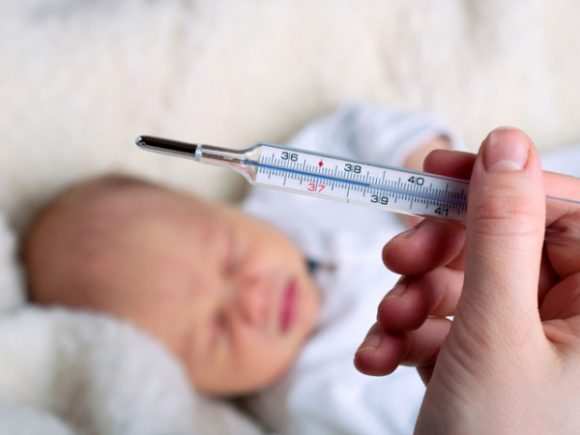
- Overheat. Babies, especially in the first six months of life, can easily become overheated. You should not put a lot of warm clothes on your child or keep them in the open sun for a long time.
- Infection. In this case, other signs appear - cough, runny nose, drowsiness, moodiness, loss of appetite and sleep. It is not difficult for a mother to understand that the child is sick.
- Teething. During this period, the child constantly scratches his gums with his fingers and pulls all objects into his mouth. The gums become swollen and inflamed.
- Reaction after vaccination. A few hours after vaccination, the temperature rises. The measles, mumps and rubella vaccine causes temperatures to rise to 39 degrees. This is a normal reaction of the body. This level lasts for about three days, in rare cases – up to 5 days. You can bring down the temperature with approved antipyretics. If snot and cough appear on the fourth day after vaccination, we can talk about a bacterial or viral infection.
- Allergy. The temperature remains high as long as the allergen is present. May be accompanied by other symptoms - rash, nasal congestion.
- Stress. After a long cry, overwork, or in the presence of nervous diseases in children of about 10 months, you can observe a rise in the mark on the thermometer.
Body temperature should not be measured every day, as this is stressful for the child. You should use a thermometer in the following cases:
- lethargy, moodiness, anxiety;
- dry mouth;
- temperature fluctuates over several days;
- pulse and breathing became frequent;
- the face turned red;
- if there is chills in the body;
- blurred vision;
- increased sweat production.
In this case, antipyretic suppositories will help. They are harmless and have a quick effect, they are convenient to use.
Types of temperature and symptoms
There are four types of hyperthermia in infants:
- Subfebrile (37-37.9 °C).
- Febrile (38-38.9 °C).
- Pyretic (39-39.9 °C).
- Hyperpyretic (over 40°C).
If you observe a baby with a temperature of 37.5 degrees, without deterioration in the general condition or additional symptoms, it means that the baby is overheated. In most cases, this temperature in a newborn is normal; a slight increase occurs due to imperfect thermoregulation.
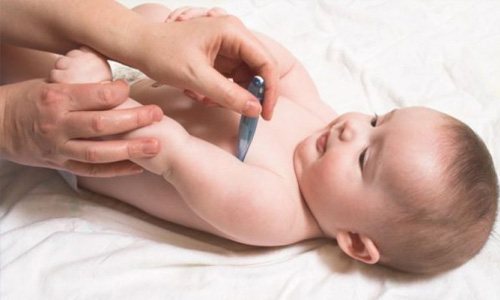
Low-grade fever is observed during ARVI - the baby experiences weakness and becomes capricious. If there is pain in the throat, the baby will have trouble eating and cry. There is also nasal congestion and sneezing. If the inflammation process descends lower into the pharynx, then pharyngitis may develop. In this case, the child will be bothered by a cough. Sleep becomes light and short.
In infectious diseases, body temperature is of a pyretic type. It is dangerous and requires immediate initiation of therapeutic treatment . The most common cause of high fever in infants is pneumonia. At the beginning of the disease there is a dry cough, which quickly turns into a wet one. Cough attacks are especially pronounced after sleep. Shortness of breath is indicated by pale skin around the mouth when crying. When breathing, the nostril wings swell and the supraclavicular areas sink.
Please note: poor thermoregulation can cause pneumonia in the absence of fever. If your child has wheezing, symptoms of respiratory failure, or cough, be sure to show him or her to the doctor.
A high temperature without symptoms of respiratory pathology indicates a urinary tract infection. It is difficult to trace pronounced symptoms in infants. Only a doctor can diagnose the disease after passing tests.
A high temperature in a newborn baby may be a symptom of omphalitis. This is an inflammation of the umbilical wound. An unhealed navel is a gateway to various types of infections. Therefore, it is important to pay attention to it when the baby has an elevated temperature. Inflammation will be indicated by redness, discharge, and suppuration in the area of the umbilical wound.
How to reduce fever in young children
Before doctors arrive, measures should be taken as quickly as possible to bring down the temperature. The following activities are allowed at home:
- drinking plenty of water;
- You can’t wrap your child up too much;
- You should do wet cleaning of the room and ventilate it;
- there should be no bright light, loud or sharp sounds in the room;
- you can make compresses - moisten a sponge with warm water and wipe the child’s body with it (you cannot wipe with alcohol or cold water, as this leads to vascular spasms);
- If you sweat excessively, change your clothes often.
Antipyretic suppositories and syrups must be appropriate for the child’s age. At home, drugs such as Nurofen, Panadol, Ibufen are allowed . You can choose any form of their release - candles, drops, syrups.
The doctor may prescribe Viferon or Genferon suppositories. They have anti-inflammatory and immunomodulatory effects, and activate the body's protective functions. With their help, you can bring down a high temperature on the third day.
Why does body temperature drop in young children?
The temperature of a baby who is under 10 months old may be slightly low and reach 36 degrees. Even if it reaches 35 degrees, but the child feels satisfactory, there is no reason to worry. If the level drops below 35, you should consult a doctor. Additional examinations will help determine what caused the low temperature.
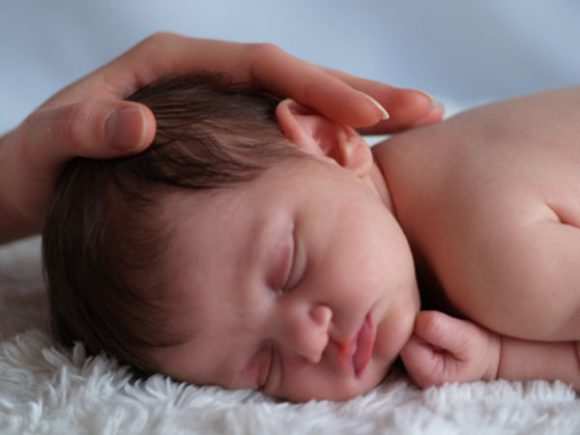
In rare cases, congenital low temperature is present (always below 36 degrees). The child feels well, so nothing needs to be done.
Low temperature in a child can be caused by various reasons.
- In premature babies, thermoregulation is impaired, so a low body temperature may be observed.
- Less heat is retained during sleep.
- Low temperature is observed with viral diseases.
- Anemia or lack of vitamins in the body leads to weakened immunity.
- A low mark on the thermometer may be a consequence of an overdose of vasoconstrictor nasal drops.
- Endocrine diseases.
- Recent use of antipyretic drugs of various forms (suppositories, drops).
- If the room is cool, then children in the first months of life easily become hypothermic.
What can you do to increase the temperature of a 10-month-old child:
- you need to wrap the child in a warm blanket and give him a warm drink;
- create all the conditions for him to have a good rest and sleep;
- you can do a warming massage;
- taking a vitamin complex.
Causes of temperature deviations in a newborn
Typically, the causes of disturbances in thermoregulation processes in adults are colds or infectious diseases. But there may be other reasons for a baby to deviate from the norm - for example, external factors or the physiological characteristics of the child.
What temperature is elevated in a baby?
As a rule, the reasons for deviations from normal temperature in a newborn are:
- the thermoregulatory system is still unformed: at birth, the child’s body temperature is kept at 37.7 degrees, and during the first three months of life it drops slightly, reaching 37-37.5 degrees;
- ingesting and digesting food: the baby’s body spends quite a lot of energy on this, especially if he is breastfed, because the baby makes some effort to suck milk from the breast; therefore, during meals, body temperature may increase;
- if the child’s body overheats from too warm clothes, being in the heat or in a stuffy room: in a baby up to four months, heat exchange has not yet been adjusted, so the child overheats very quickly and also quickly becomes hypothermic;
- vaccination: as a result of vaccination, body temperature can increase significantly, reaching 38 degrees and above;
- eruption of the first teeth (incisors, canines and molars) is one of the most common causes of fever up to 39 degrees, which can last for several days; at the same time, along with the temperature, the baby may have all the signs of a cold - runny nose with clear discharge, drooling, poor appetite;
- thirst and dehydration in the heat can also cause an increase in body temperature, especially if the child is active at this time.
In addition to environmental factors, an increase in temperature in a baby can occur due to internal problems in the body:
- with constipation that lasts more than one day;
- for a cold (signs of a cold can be sneezing, runny nose, cough, loss of appetite, poor general health);
- with intestinal infection;
- the temperature may exceed 39 degrees if the child is infected with rubella, measles, scarlet fever, or rotavirus;
- if the mucous membrane of the nose, pharynx, ears, eyes is inflamed.
But even a serious increase in body temperature in an infant (up to 38 degrees) can be normal. Therefore, the main thing in such situations is the general condition of the child. If he is not crying or too sleepy, if he is in a cheerful mood and shows a desire to eat or play, there is no need to worry. But still carefully watch your child throughout the day.
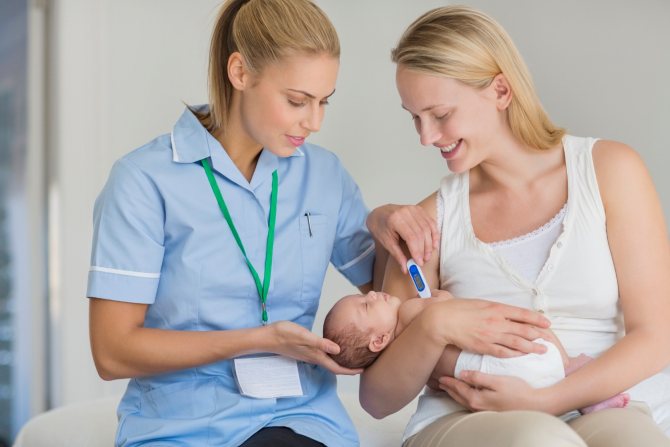
What temperature is considered low in newborns?
Typically, normal body temperature in infants does not fall below 36 degrees. If you observe that your body temperature has dropped below this indicator, the reasons may be as follows:
- this is possible in the first day after birth and in the next three months after birth;
- the child is hypothermic: even slight hypothermia of the baby will immediately cause his body temperature to drop; therefore, try to dress your child one layer of clothing warmer than yourself;
- You may have given your child an antipyretic to make him feel better during his illness, but his body has not yet adapted to the artificial decrease in temperature;
- the child has just woken up: the body temperature of newborns decreases significantly during sleep, so you should not put a thermometer on him immediately after waking up, and especially when he is sleeping;
- as a result of using a vasoconstrictor drug for the common cold;
- with a viral disease; if the baby catches the virus, the temperature may drop below 36 degrees and stay at this level for up to 3-4 days; The child will be lethargic and will sleep more than usual.
When should you seek help?
It is important to consider how many days the high or low number lasts. Doctors' help should be sought when the baby's body temperature, especially under the age of 10 months, is accompanied by other symptoms.

- The disorder occurred in a child less than three months old.
- The appearance of seizures.
- The child's neck becomes tense and difficult to bend forward.
- Severe runny nose, attacks of suffocation, wheezing, wheezing.
- Profuse regurgitation.
- Loose stools with foam and streaks of blood.
- Rare urination, change in urine color.
- The appearance of a rash on the skin.
- Body temperature remains high for more than five days.
- Does not interfere with antipyretics. Suppositories and other medications do not help or last no more than two hours.
- There are chronic diseases of the heart, kidneys or other organs.
- Low body temperature is accompanied by bluish skin, drowsiness, and poor appetite. A low reading on the thermometer in children under 10 months of age can be life-threatening for the child.
It is necessary to constantly monitor the condition of a small child. Features of the structure and functioning of internal organs in infants contribute to the rapid spread of the disease. It is important to recognize the disorder in the early stages in order to prevent serious complications.
